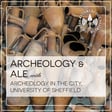
An Exploration of Sheffield's Ancient Village Suburbs with David Templeman - Ep 36
Archaeology and Ale is a monthly series of talks presented by Archaeology in the City, part of the University of Sheffield Archaeology Department’s outreach programme. This month we are proud to host David Templeman speaking on "An Exploration of Sheffield's Ancient Village Suburbs
with David Templeman". This talk took place on Thursday, February 25th, 2021, online via Google Meets.
David is a retired businessman, having worked in the leisure trade most of his working life. With a lifelong interest in history, on retirement, he indulged that passion by joining Sheffield Manor Lodge initially as a guide. Since then he has become an accomplished speaker giving talks all over the country on Elizabethan history with local connotations. In 2016, he became an author when his book “Mary, Queen of Scots the Captive Queen in England 1568-87” was launched to critical acclaim. The book has now sold just under 3,000 copies and has become recognised as the definitive version of the English captivity of Mary, Queen of Scots. David is a Member of the Marie Stuart society of which he has developed close links. He is also chair of the Friends of Sheffield Manor Lodge, which has almost 400 Members, with the current Earl of Shrewsbury as their patron. Over the last few years, David has devoted his research into bringing the old Sheffield- the one prior to the 19th century back into the public domain with a number of very popular talks, none more so than the Ancient Suburbs series.
For more information about Archaeology in the City’s events and opportunities to get involved, please email archaeologyinthecity@sheffield.ac.uk or visit our website at archinthecity.wordpress.com. You can also find us on Twitter (@archinthecity), Instagram (@archaeointhecity), or Facebook (@archinthecity).
AffiliatesFind this show on the educational podcast app, Lyceum.fm!